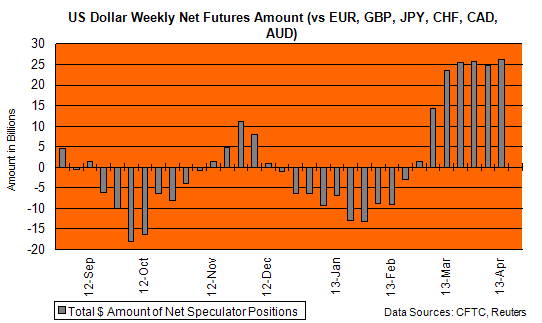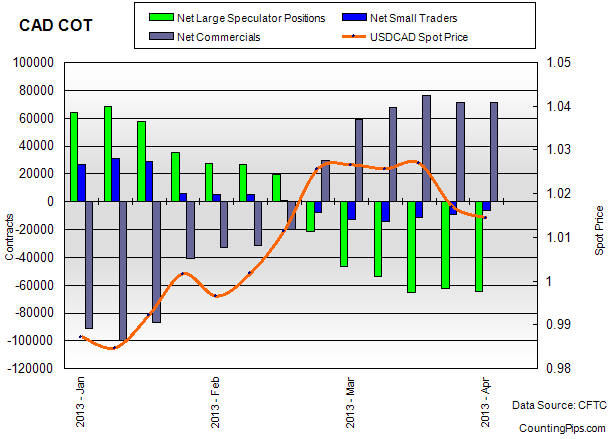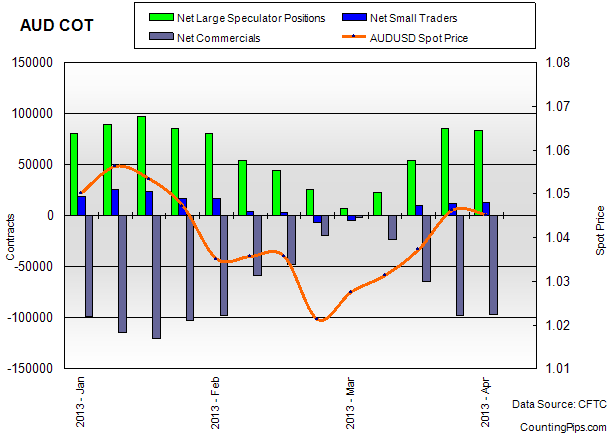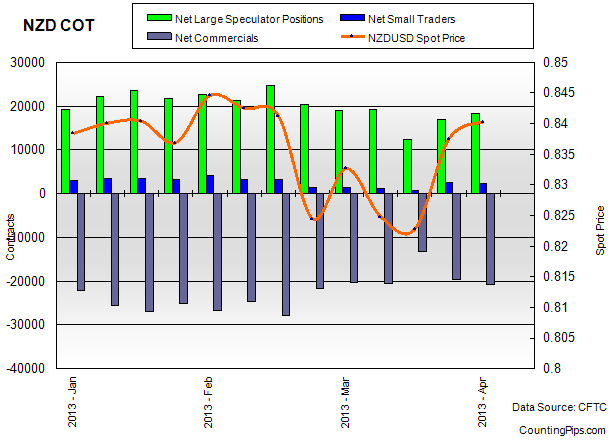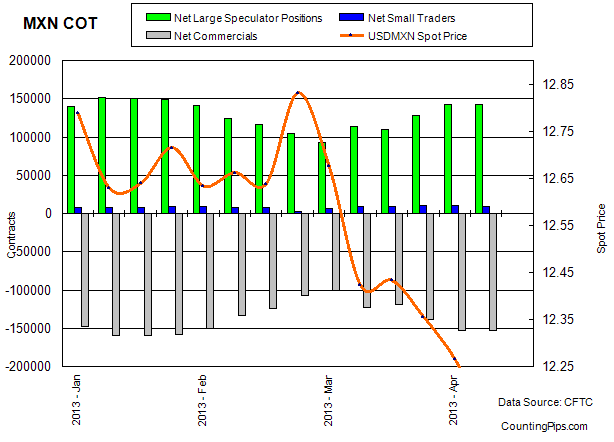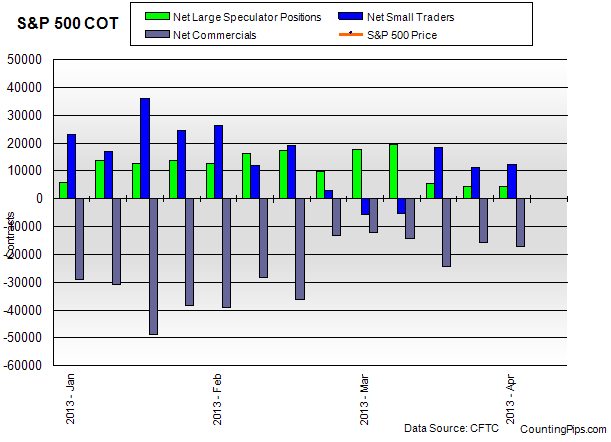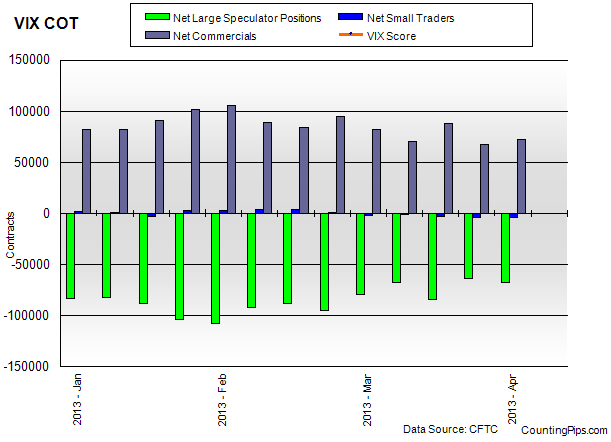By CountingPips.com
The latest weekly Commitments of Traders (COT) report, released on Friday by the Commodity Futures Trading Commission (CFTC), showed that large futures traders raised their total bullish bets of the US dollar last week and brought positions to a new high level since July 2012, according to Reuters.
Non-commercial large futures traders, including hedge funds and large International Monetary Market speculators, registered an overall US dollar long position of $26.3 billion as of Tuesday April 2nd. This was an advance from the total long position of $24.8 billion on March 26th, according to position calculations by Reuters (US dollar positions against the total positions of eurofx, British pound, Japanese yen, Australian dollar, Canadian dollar and the Swiss franc).
Individual Currencies Large Speculators Positions in Futures:
The individual currency contracts quoted directly against the US dollar last week saw increases for the British pound sterling, Japanese yen, Swiss franc, New Zealand dollar and the Mexican peso while the euro, Australian dollar and the Canadian dollar all had a declining number of net contracts for the week.
Individual Currency Charts:
EuroFX: Weekly change of -16,606
EuroFX: Large trader positions for the euro fell last week for a third straight week. Euro contracts declined to a total net position of -65,701 contracts in the data reported for April 2nd following the previous week’s total of -49,095 net contracts on March 26th. This is a change of -16,606 contracts from the previous week.
Euro positions are at a new low level for 2013 and the lowest standing since November 27 2012 when positions stood at -66,693 contracts.
British Pound Sterling: Weekly change of +1,535
GBP: British pound spec positions halted their decline of ten consecutive weeks last week as positions increased slightly. British pound speculative positions edged up last week to a total of -65,020 net contracts on April 2nd following a total of -66,555 net contracts reported for March 26th. This was a weekly change of +1535 in large trader contracts.
Pound speculator positions have been in a bearish position for eight consecutive weeks since crossing over on February 5th.
Japanese Yen: Weekly change of +10,978
JPY: Japanese yen net speculative contracts rose last week after declining the previous week. Japanese yen positions increased to a total of -78,171 net contracts on April 2nd following a total of -89,149 net short contracts on March 26th. This is a weekly change of +10,978 positions.
Swiss Franc: Weekly change of +183
CHF: Swiss franc speculator positions edged up slightly last week after falling for five out of last six weeks. Net positions for the Swiss currency futures rose slightly to a total of -12,015 contracts on April 2nd following a total of -12,198 net contracts reported for March 26th. This is a weekly change of +183 contracts.
Canadian Dollar: Weekly change of -1,899
CAD: Canadian dollar positions decreased slightly last week after ending a streak of nine consecutive weeks of decline the previous week. Canadian dollar positions fell to a total of -64,544 contracts as of April 2nd following a total of -62,645 net contracts that were reported for March 26th.
This is a weekly change of -1,899 net contracts following a weekly change of +2,686 the previous week.
Australian Dollar: Weekly change of -1,544
AUD: The Australian dollar fell slightly last week after rising sharply for three consecutive weeks. Aussie speculative futures positions decreased to a total net amount of +83,971 contracts on April 2nd after totaling +85,515 net contracts as of March 26th. This is a weekly change of -1544 in net positions following the previous week’s +31,460 change.
Australian dollar contracts, two weeks ago, were at their highest level since January 22, 2013 when positions equaled +97,011 contracts.
New Zealand Dollar: Weekly change of +1,471
NZD: New Zealand dollar speculator positions advanced last week for a second consecutive week. NZD contracts rose to a total of +18,387 net long contracts as of April 2nd following a total of +16,916 net long contracts on March 26th. This constitutes a weekly change of +1,471 following the previous week’s change of +4,439 net contracts.
Mexican Peso: Weekly change of +14,593
MXN: Mexican peso speculative contracts rose last week for a second consecutive week. Peso positions increased to a total of +142,755 net speculative positions as of April 2nd following a total of +128,162 contracts that were reported for March 26th. This is a weekly change in net large peso speculator positions of +14,593 contracts following the previous change of +18,786 contracts.
Peso speculative positions have been over the +100,000 threshold for four straight weeks after falling under this level on March 5th for the first time since November 27th 2012.
Additional Macro Financial Markets:
10 Year Treasuries: Weekly change of +12,502
10 Year Notes: 10-Year Treasury Note speculative contracts moved higher last week to increase for a third consecutive week. 10-Year positions rose to a total of +110,692 net speculative positions as of April 2nd following a total of +98,190 contracts that were reported for March 26th. This is a weekly change in net large speculator positions of +12,502 contracts following the previous week’s change of +101,485 contracts.
10-Year Treasury speculative positions are at their highest level since February 26th when positions equaled +115,908 contracts.
Crude Oil Light Sweet: Weekly change of +4,243
Crude Oil: Crude Oil speculative contracts increased last week for a second straight week. Crude spec positions rose to a total of +248,850 net speculative positions as of March 26th following a total of +244,607 contracts that were reported for March 26th. This is a weekly change in net large speculator positions of +4,243 contracts.
Crude Oil speculative positions are at their highest level since February 19th when positions reached +257,918 contracts.
Gold Futures CMX: Weekly change of -12,240
Gold: Gold speculative contracts declined last week to fall for a second straight week. Gold futures positions declined to a total of +120,206 net speculative positions as of April 2nd following a total of +132,446 contracts that were reported for March 26th. This is a weekly change in net large speculator positions of -12,240 contracts.
Gold speculative positions have been on a steady decline since reaching an apex on October 9th 2012 at +211,949 contracts.
S&P 500 Index Futures: Weekly change of +161
S&P 500: S&P 500 speculative contracts edged higher last week after falling for two weeks in a row. S&P 500 futures positions rose to a total of +4,532 net speculative positions as of April 2nd following a total of +4,371 contracts that were reported for March 26th. This is a weekly change in net large speculator positions of +161 contracts.
VIX Futures: Weekly change of -4,690
VIX: VIX speculative contracts decreased last week after reaching the highest level (or lowest short level) since August 2012 on the previous week. VIX futures positions fell to a total of -68,273 net speculative positions as of April 2nd following a total of -63,583 contracts that were reported for March 26th. This is a weekly change in net large speculator positions of -4,690 contracts.
The Commitment of Traders report is published every Friday by the Commodity Futures Trading Commission (CFTC) and shows futures positions data that was reported as of the previous Tuesday (3 days behind).
Each currency contract is a quote for that currency directly against the U.S. dollar, a net short amount of contracts means that more speculators are betting that currency to fall against the dollar and a net long position expect that currency to rise versus the dollar.
(The graphs overlay the forex spot closing price of each Tuesday when COT trader positions are reported for each corresponding spot currency pair.)
See more information and explanation on the weekly COT report from the CFTC website.
Article by CountingPips.com – Forex News & Market Analysis
